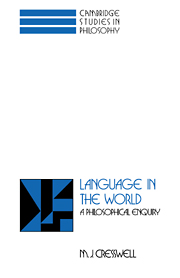Book contents
- Frontmatter
- Contents
- Preface
- Introduction
- 1 A simple formal language
- 2 Predicates and functors
- 3 The isomorphism problem
- 4 Quantification
- 5 Transmundism
- 6 Putnam's ‘Meaning of “meaning”’
- 7 Lewis on languages and language
- 8 Causation and semantics
- 9 Belief–desire psychology
- 10 Direct knowledge
- References
- Index
- Frontmatter
- Contents
- Preface
- Introduction
- 1 A simple formal language
- 2 Predicates and functors
- 3 The isomorphism problem
- 4 Quantification
- 5 Transmundism
- 6 Putnam's ‘Meaning of “meaning”’
- 7 Lewis on languages and language
- 8 Causation and semantics
- 9 Belief–desire psychology
- 10 Direct knowledge
- References
- Index
Summary
We know a lot about the semantic structure of natural language. If you think that semantics is about the connection between linguistic entities, words, sentences and such, and non-linguistic entities, things ‘in the world’, then the way to do semantics will be to specify the linguistic entities, then specify the ‘things in the world’ which are to be their meanings, and then connect up the two. Chapters 1 and 2 illustrate this by setting out in detail a very simple formal language together with its semantics. This semantics allows us to address the philosophical issues with a particular example in mind. (These chapters can be omitted by those who already have a background in formal semantics.) The kind of semantic theory set out is what is called possible-worlds semantics, and is based on the idea that the meaning of a sentence is the conditions under which it is true, and that these conditions are simply the class of possible worlds in which the sentence is true.
Many years ago, in Cresswell 1978, I defended this approach to semantics by arguing that speakers of a language know the truth conditions of the sentences they utter, and that it is this knowledge which constitutes their semantic competence. It was David Lewis who, when I gave this talk at Princeton in 1975, convinced me that there was a problem. I had argued that to know meaning is to know truth conditions. Lewis asked what it is to know truth conditions. If an interpretation to a language is a pairing of expressions with their meanings then the fact that certain expressions are paired with certain meanings will be a mathematical (or logical) fact.
- Type
- Chapter
- Information
- Language in the WorldA Philosophical Enquiry, pp. 1 - 4Publisher: Cambridge University PressPrint publication year: 1994

